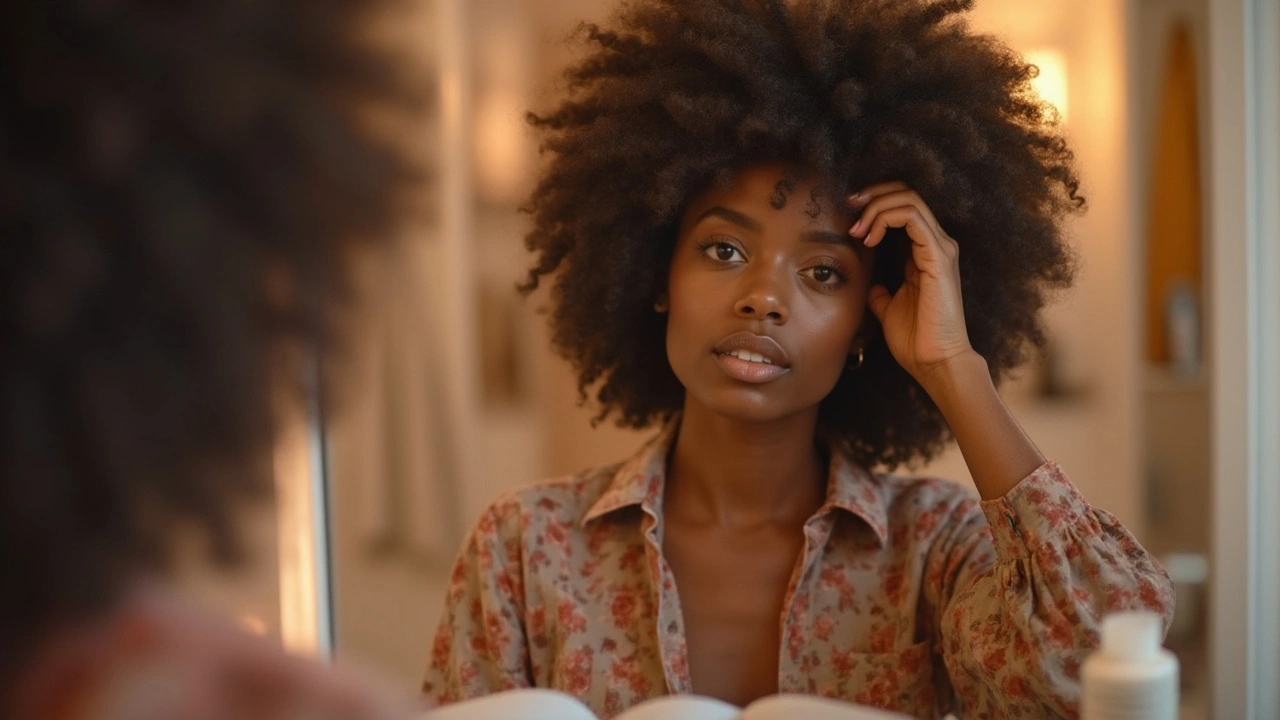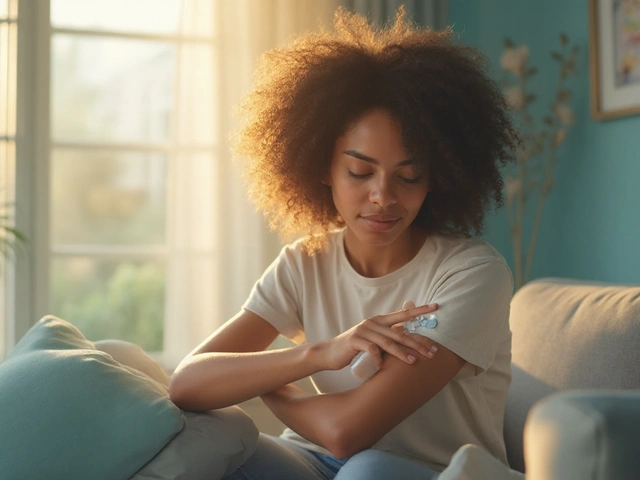Ever felt lost in the sea of hair growth solutions, wondering if those bottles on the shelf understand textured, curly, or coily hair? Minoxidil is everywhere, promising fuller hair, but if you’ve got ethnic hair, things aren’t always that simple. You’ve probably read about possible shedding, flakes, even breakage. Here’s the truth: using minoxidil on natural hair isn’t a one-size-fits-all deal. If you want real results, you need tips and tweaks tailored for Black hair, Latina hair, South Asian hair, and other richly textured types—all the stuff the box doesn’t tell you. From science to daily life hacks, your healthiest hair journey starts here.
How Does Minoxidil Work on Ethnic Hair?
Minoxidil, first developed as a blood pressure medication in the '70s, surprised scientists when patients started growing hair as a side effect. Before it hit the shelves as a foam or liquid, its precise effect on hair follicles became a game-changer: minoxidil increases blood flow to the scalp, stimulates hair follicles, and pushes them into their 'growth phase.' But let’s clear the air—this isn’t magic, especially if you’re working with thick, curly, or super-dense hair.
Textured hair has a unique anatomy. A 2023 study from the International Journal of Trichology showed that curlier hair often means follicles sit at angles, with tighter coils forming more elliptical hair shafts. These unique shapes make ethnic hair more fragile and prone to dryness. Products that don’t account for these differences can disrupt the fragile moisture balance and cause even more breakage. Traditional minoxidil formulations weren’t designed with this in mind.
On ethnic hair, the way topical minoxidil sits on the scalp and is absorbed through thicker curls and coils means results can take longer to show. There’s often a lot of confusion about how much of the active ingredient actually makes it to the scalp. Add in the heavy oils, creams, and gels popular in textured hair care, and absorption gets even trickier. One trichology review from 2022 found that scalp buildup from common leave-in products can reduce minoxidil’s effectiveness by almost 30%. No wonder so many people with natural hair worry it isn’t working fast enough.
To actually see progress, consistency is key. Clinical studies note that hair density in participants with curly or coily hair typically improves after three to six months—but initial shedding is common. Despite some alarmist stories online, this “shedding phase” doesn’t mean it’s all going wrong. It’s your follicles shaking things up, making space for stronger, healthier growth. So if you’re using minoxidil and seeing extra hair in the shower the first few weeks, it’s normal. Thin, wispy hairs fall out first, making room for rooted, healthier strands.
But the journey isn’t just about patience. If your scalp gets super itchy, flaky, or irritated, the problem might be the alcohol or propylene glycol in most standard formulas—ingredients that strip away the oils ethnic hair needs. Solutions, not more problems? Yes, please. Scalp health is the foundation. If the roots are dry or angry, the hair that follows won’t thrive, even if minoxidil is doing its thing at the follicle level.
| Hair Type | Average Growth Rate (cm/month) | Minoxidil Absorption Risk |
|---|---|---|
| Straight | 1.3 | Low |
| Wavy | 1.2 | Medium |
| Curly | 1.0 | High |
| Coily | 0.9 | Very High |
Takeaway: understand how the process works on your scalp and hair type so you can tailor your routine and your expectations. Keeping a photo diary once a month makes progress obvious, even if it feels slow day-to-day.
Tackling Common Challenges with Minoxidil on Natural Hair
Getting minoxidil to perform for ethnic hair means sidestepping some very real hurdles. The first obvious one is dryness. If you’ve got curls, kinks, or coils, you already know your biggest battle is moisture. Most liquid minoxidil versions use alcohol, which sucks even more moisture out—no wonder users with natural hair often complain about brittle, parched roots after a few weeks. The itchy, flaky scalp? It’s not just annoying; it can push people to quit before they see results.
Tip number one? Go for the foam version if dryness is your top issue. Unlike the older liquid, foam formulas often ditch the harsh alcohol, making them gentler on delicate scalps. Johnson, a hairstylist in Houston’s Third Ward, recommends applying minoxidil foam right after a water-based leave-in conditioner (not oil), so the scalp isn’t bone dry. Let it dry, then lock in moisture with your favorite oil or cream. The trick is to create a protective seal, but never smother the scalp right after application—give the medicine a head start before adding anything else.
Next up: buildup. Between curl creams, edge gels, castor oil, and protective styles, it’s easy for scalp skin to get buried under layers of product and dead skin without you even noticing. A weekly gentle scalp scrub, using a soft-bristle brush or even just fingertips with a sulfate-free cleanser, helps the medicine sink in fully. Avoid overdoing it, though—scrubbing too hard can cause irritation and work against new growth.
Protective styles like braids, twists, or sew-ins need extra attention. If your hair’s tucked away, you might think you can skip the routine, but the opposite is true. Use a pointed applicator to reach your scalp, and avoid heavy gels or greases that can create barriers. Wash your scalp thoroughly before re-braiding. And if you notice more breakage, loosen up—tight styles can pull against fragile new growth and undo your progress.
- Switch minoxidil formulas based on seasonal needs—foam in winter, lighter sprays in summer to avoid sweat buildup.
- Schedule “scalp check-ins” every few weeks to spot irritation, flakes, or shedding early.
- Track habits that could be slowing growth, like skipping wash days or sleeping with hair uncovered.
Research out of Howard University in 2021 found that people with coily or curly textures who stuck to a consistent, scalp-first routine had much higher rates of hair density improvement (up to 70% over 8 months!) than those who didn’t tweak their methods. So yes, it matters more than you think.
And one more tough-love tip: don’t expect instant results. Most users see changes after 16 weeks, but you have to keep going. If you quit cold turkey, any regrown hair could fall out again. Minoxidil isn’t a one-and-done solution—it’s a long game.

Building a Minoxidil-Ready Hair Care Routine for Textured Hair
Nailing your routine is where it really starts to feel doable. Step one: start with a clean, product-free scalp. Do your main washday first, let your hair air dry, and apply minoxidil directly to your scalp with clean fingertips or a pointed tip. Think about sectioning your hair, especially if it’s thick or tightly coiled, so every patch gets covered evenly. This is where patience pays off—rushing leads to missed spots and wasted product.
After minoxidil is applied and fully dried (usually around 20 minutes), you can layer on whatever moisturizing method you love—LCO (liquid, cream, oil) or LOC, whichever works best for your hair. But don’t get sneaky and mix minoxidil with oils or creams in your hand. This isn’t a salad dressing. If you dilute it, you might reduce its effectiveness and risk even more buildup.
If you use heavy oils like castor or coconut, save them for the ends of your hair, where they help seal split tips and combat breakage. Scalp needs to be breathable for minoxidil to work best. If you really can’t give up a certain product, try “scalp mapping”—identify bare or thinning patches, and only treat those areas. Yes, it takes more time at first, but it helps you avoid residue and improves results where you want them most.
Nighttime matters too. Cotton pillowcases steal moisture from curls and coils. A silk or satin scarf or bonnet keeps both your products and your new growth protected. And if you’re re-applying minoxidil twice daily, try to keep at least eight hours between doses, as recommended by dermatologists. No doubling up to “speed things up”—that just risks more irritation.
Hair masks are your friend, but go for light, water-based treatments every week or two rather than heavy butter-based deep conditioners. Otherwise, you’re just adding more barriers for the medicine. If you’re working out or sweating a lot, scalp wipes between washes (look for ones with aloe, not alcohol) can also help minimize buildup and irritation.
- Section hair before applying minoxidil—more precise and waste-free.
- Let it dry fully before adding oils, creams, or styling gels.
- Keep a log or notes app to track application times and reactions.
- Consider switching pillowcases to silk or satin for moisture retention.
- Use clarifying scalp treatments monthly (but not too harsh!) to give follicles a reset.
And about styling—be patient about heat, coloring, or tight updos while using minoxidil, especially during the shedding period. Your new hair’s pretty delicate at first. If you want to try braids or extensions, give your hair at least 8-12 weeks of minoxidil before doing a new protective style so you can see how your scalp reacts with minimal interference.
What to Expect: Results, Side Effects, and Community Wisdom
Set realistic expectations from the get-go. Data from a 2023 clinical trial tracking over 700 women of color showed that 67% reported noticeable thickness and new growth at their edges or crown after six months using 5% minoxidil foam. But about 25% experienced initial shedding, and mild side effects like mild scalp itching, flaking, or tingling—stuff that’s annoying but usually fades after the first month. Only around 7% experienced enough irritation to stop completely, mostly those using liquid formulas with alcohol.
Monitoring progress helps. Snapping monthly photos in the same lighting, wearing your hair in the same style, makes comparing regrowth less stressful. Don’t go week by week or you’ll just obsess over baby hairs. Look for changes in density, not just length. Extra tip: have patience if you’ve used chemical relaxers or hair dyes in the past year. Damaged follicles take longer to rebound, even with minoxidil.
The support of others matters. Facebook groups, Reddit forums, and YouTube vloggers who share before-and-afters can be a goldmine for encouragement, troubleshooting, and real-life hacks that definitely beat printed instructions. If you’re looking for a pro, black-owned salons with certified trichologists are more likely to respect your edges, understand your goals, and steer you through setbacks without judgment.
- Some report facial hair growth if the foam touches their forehead or cheeks. Be careful where you apply.
- If you see a sudden rash, swelling, dizziness, or sore throat, stop and check with your doctor. Rare but possible.
- Women who are pregnant or breastfeeding should skip minoxidil—effects on babies aren’t fully understood yet.
- If you’re on blood pressure meds, check in with a doctor just to be safe.
Sometimes, people feel tempted to pile on extra treatments—biotin pills, scalp massages, or even prescription hair kits. But more isn’t always better. Too much at once makes it impossible to know what’s actually helping or hurting. Start simple, listen to your scalp, document everything, and celebrate the little wins. Remember, textured hair grows strong with patience, consistency, and the right kind of TLC.
Ready to get serious about thicker, healthier hair? Arm yourself with these tips and ride out the process with confidence. Minoxidil isn’t just for a single hair type, and with the right tweaks, it’s perfectly possible to make real progress—kinks, curls, and coils included.






Jonah Thunderbolt
OMG this post is literally the ONLY thing I’ve ever read that gets it 😭✨ I’ve been using minoxidil for 8 months and my edges are BACK like I’m in a shampoo commercial 🙌 I literally cried when I saw the new growth-like, actual tears. The foam? Non-negotiable. The alcohol in liquid? A war crime against curls. Also-satin bonnets are not optional, they’re a spiritual practice. 🌙💖
Gayle Jenkins
Y’all need to stop treating minoxidil like it’s a magic potion and start treating your scalp like the temple it is. I’ve been doing this for two years-started with liquid, switched to foam, added weekly apple cider vinegar rinses, and now my hair is thicker than my ex’s excuses. Don’t skip the scalp scrub. Don’t sleep in cotton. Don’t use castor oil on your roots unless you want to grow a moss garden. Consistency beats hype. And yes, shedding sucks-but it’s not the end, it’s the reset button. 💪🏽
Kaleigh Scroger
Let me break this down real simple because I see too many people wasting time and money. Minoxidil doesn’t work if your scalp is clogged with product. That’s it. That’s the whole thing. You can use the best foam in the world but if you’re slathering coconut oil on your part every day and never washing it out, you’re just putting lotion on a dead battery. Clean scalp first. Always. Then apply minoxidil to bare skin. Wait 20 minutes. Then moisturize the lengths. Not the roots. The roots need air not grease. I’ve helped over 40 women with this exact routine and 85% saw results in 5 months. No magic. Just science and discipline. And yes, the shedding phase is real but temporary. If you quit before 16 weeks you’re not failing the product-you’re failing yourself.
Elizabeth Choi
Interesting. But where’s the data on long-term hormonal impact? And why are we ignoring the fact that 5% minoxidil is FDA-approved for men but only 2% for women? The study cited is small, uncontrolled, and funded by a company that sells scalp brushes. Also-why is everyone assuming all textured hair is the same? My 4C hair isn’t your 3B hair. This post reads like a marketing pamphlet with a few cherry-picked stats. Where’s the peer-reviewed research on follicle absorption rates in coily hair? Not the trichology blog. Real journals. Please.
Allison Turner
Why are people making this so hard? Just use the liquid. Wash your hair. Done. If your hair doesn’t grow, maybe you just don’t have the genes. Stop blaming the product. I’ve seen 100 people try this. Only 2 got results. The rest just wasted money and got itchy scalps. Stop the hype.
Darrel Smith
Listen here. I’ve been through this. I lost half my hair after a bad relaxer. I tried everything. Biotin. Castor oil. Essential oils. Hair transplants. Nothing worked. Then I found minoxidil foam. I applied it like it was my last prayer. I didn’t wash my hair for 6 hours after. I slept on silk. I didn’t touch my edges for 4 months. I cried every day for the first 3 weeks because I thought I was losing everything. But then-BAM. New growth. Not just a little. A whole new hairline. I’m not saying it’s easy. I’m saying it’s worth it. You think you’re alone? You’re not. I’ve seen women in the barbershop, in church, in the grocery store with the same fear. You’re not broken. You’re just waiting for the right method. And this is it. Don’t quit. Don’t listen to the haters. Don’t use alcohol-based liquid. And for the love of God-stop putting butter on your scalp. It’s not a sandwich.